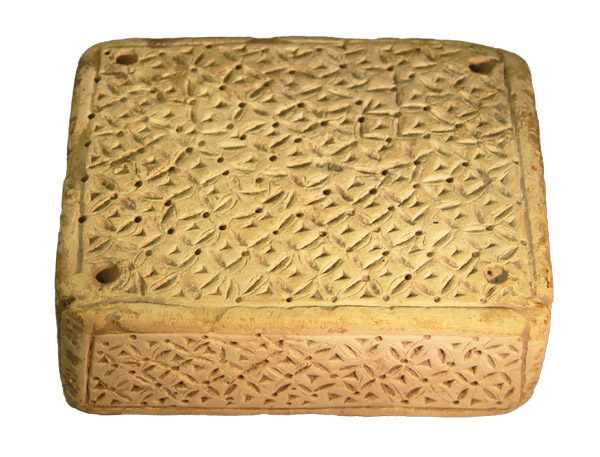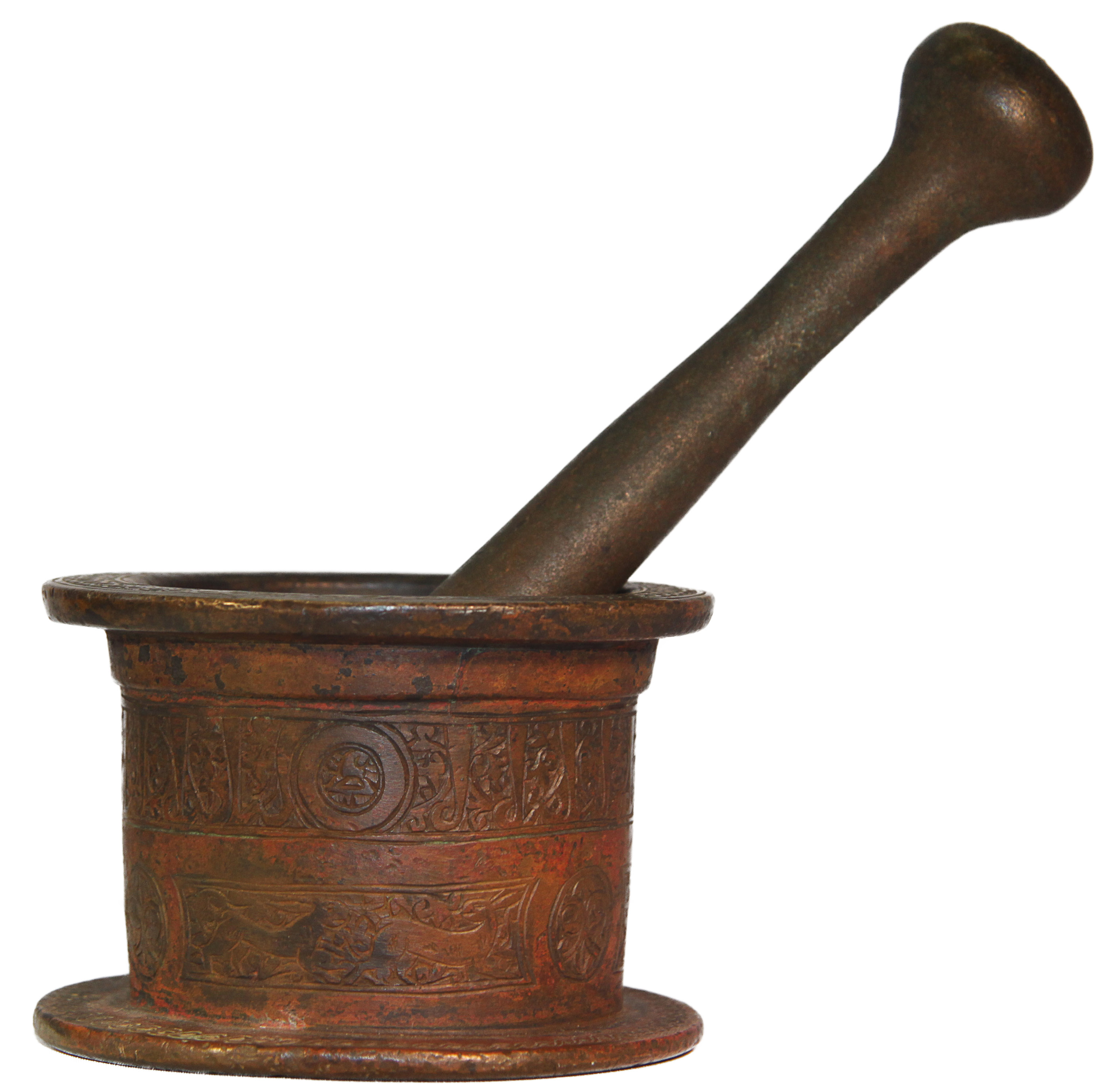Hanson Collection of Early Islamic Artifacts
Islamic Ceramic Clay Stand
Syrian or Egyptian
original
date: c. 7th-9th Century AD
gift of: Professor Gary Hanson
provenance: unknown
description: Our terracotta stand presents a mystery in terms of function and origin. The decorations were incised into the terracotta, probably with a stylus, and at first glance appear to mimic ancient cuneiform writing. On closer examination they resemble flowers, whose representation was permitted in Islam, though it forbade the representation of humans or animals on objects of religious significance. The holes at the corners of the top surface may have held wooden or metal rods that may have held a book.
If this item is correctly dated, it was made on the cusp of the rise of Islam when its art was slowly gaining influence in the Near East. Until other comparable pieces are found it is difficult to gauge the function of the object and the extent of Islamic influence on its decoration.
Khorassan Decorated Bronze Inkwell
Persian
original
gift of: Professor Gary Hanson
date: 12th Century AD
provenance: Khorassan
description: This inkwell was found in Khorassan, a province of Persia which is modern day Iran. The general shape of our inkwell is very typical of other inkwells of the same time period. It is bronze and may have had a silver inlay that has worn off. Bronze and bronze alloys were among the most important materials for artisans in the Islamic world. Roundels featuring harpies or sphinxes repeat along its body, and a roundel of a bird features on the base. The fantastic harpies and sphinxes came from Greek mythology, while birds are generally thought to have had positive associations in Islam, and are found on numerous pieces. There appears to be a kufic inscription on the lid. Common inscriptions include “peace be upon him [Muhammad]” and wishes of good fortune and blessing, the name of the creator, the date and place of production, or quotes from the Qur’an. Literacy was fairly widespread in the Muslim world, and many objects have inscriptions. The effort put into its decoration shows the importance of this object, demonstrating the wealth and social standing of the owner. The loops on this inkwell would have had string or chain through them, which could be used to attach the inkwell to the owner’s body, a popular fashion accessory for the literate.
Khorassan Decorated Bronze Mortar and Pestle
Persian
original
gift of: Professor Gary Hanson
date: 11th Century AD
provenance: Khorassan
description: Metal, often bronze, was frequently used in the manufacture of objects of daily life in the Islamic world, such as this mortar and pestle, found in the area historically designated Khorassan in Iran. Many of examples of these objects have been found in what is now east or north east Iran. Though this was a common household object, it was intricately and beautifully decorated. The simplicity of the pestle is made up for by the extravagant designs on the mortar, which consist of an exceptionally beautiful combination of figural and non-figural motifs. The top registers contain kufic script over a vegetal pattern, while bottom registers contain different animals (rabbits, deer, and large cats). The protruding top and bottom rims are decorated with geometric designs. Along with calligraphy, vegetal and geometric patterns constitute the three non-figural decorative patterns in Islamic Art. The use of geometric design is a common feature in artefacts produced after the 9th century and has been related to the flourishing
of mathematics under the Abbasid caliphs who ruled from the 9th to 11th.
Lion Head Protome
Persian
original
gift of: Professor Gary Hanson
date: c. 9th-10th Century AD
provenance: unknown
description: The original function of this object is difficult to determine. This lion head is likely a protome from a large bronze bowl or ewer, or might instead be the head of a figurine or a zoomorphic (animal) shaped incense burner. It is made of cast bronze, like other figurines from this time period. Later bronze animal figurines were elaborately decorated, but ours is simple. Animals long played an important role in Islamic culture, both in literature and art. Lions might best a man or take down a deer in art. Islam forbade the representation of living creatures in the visual arts because the creation of beings was reserved for God alone. It is apparent, though, that people, animals and mythical creatures festooned or constituted many pieces of secular Islamic art. Therefore, as this lion head proves, there was a division between art and objects created for religious and secular use.
Nishapur Pottery Bowl with Peacocks and Fish
Persian
original
gift of: Professor Gary Hanson
date: c. 11th-12th Century AD
provenance: Nishapur
description: This bowl was found in Nishapur, in present day north-eastern Iran, a region that often changed rulers. The bowl is earthenware with a white slip and detailed, hand painted decorations, with a clear glaze on the surface. The fish and peacock motifs and the usage of dots are very common on pottery found throughout the Near East. The peacock was part of a Persian folklore creation story, and in Islam the spreading tail of the peacock was both a symbol of the universe and a representation of two opposing symbols of light, the moon and sun. Fish have connotations of wisdom in Islam. Though beautiful, this bowl would have been used every day, as most pottery was decorated and people took pride in owning and using beautiful objects. As Islam forbad the depiction of animals and humans, this bowl would have been used in a household and not a mosque.
While this bowl was found in Nishapur, it is difficult to know whether it wasproduced there or imported. Potters were itinerant because they could buy
paints in marketplaces and kilns were relatively easy to set up.




